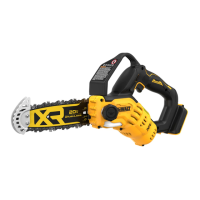7
ENGLISH
13 . Use extreme caution when re‑entering a previous cut.
Engage the ribbed bumpers
21
onto the wood and allow
the chain to reach full speed before proceeding witha cut.
14 . Do not attempt plunge cuts or borecuts.
15 . Watch for shifting logs or other forces that could
close a cut and pinch or fall intochain.
Kickback Safety Features
WARNING: The following features are included
on your saw to help reduce the hazard of kickback;
however such features will not totally eliminate this
dangerous reaction. As a pruner user do not rely
only on safety devices. You must follow all safety
precautions, instructions, and maintenance in this
manual to help avoid kickback and other forces which
can result in seriousinjury.
• Reduced‑Kickback Guide Bar, designed with a small radius
tip which reduces the size of the kickback danger zone on
bar tip. A reduced ‑ kickback guide bar is one which has
been demonstrated to significantly reduce the number and
seriousness of kickbacks when tested in accordance with
safety requirements for electric pruners.
• Low‑Kickback Chain, designed with a contoured depth
gauge and guard link which deflect kickback force and
allow wood to gradually ride into the cutter. A low‑kickback
chain is a chain which has met kickback performance
requirements of ANSI B175.1–2012.
• Do not operate pruner while in a tree, on a ladder, on a
scaffold, or from any unstablesurface.
• Hold tool by insulated gripping surfaces when performing
an operation where the cutting tool may contact hidden
wiring. Contact with a “live” wire will make exposed metal
parts of the tool “live” and shock theoperator.
• Do not attempt operations beyond your capacity or
experience. Read thoroughly and understand completely all
instructions in thismanual.
• Before you start pruner, make sure saw chain is not
contacting anyobject.
• Do not operate a pruner with one hand! Serious injury to the
operator, helpers, or bystanders may result from one handed
operation. A pruner is intended for two‑handed useonly.
• Keep the handles dry, clean, and free of oil orgrease.
• Do not allow dirt, debris, or sawdust to build up on the
motor or outside airvents.
• Stop the pruner before setting itdown.
• Do not cut vines and/or small underbrush.
• Use extreme caution when cutting small size brush and
saplings because slender material may catch the saw chain
and be whipped toward you or pull you offbalance.
• Drive Sprocket or Sprocket ‑ The toothed part that drives
the sawchain.
• Felling ‑
The process of cutting down atree.
• Felling Back Cut ‑
The final cut in a tree felling operation
made on the opposite side of the tree from the notchingcut.
• Front Handle ‑ The support handle located at or toward
the front of the pruner.
• Front Hand Guard ‑ A structural barrier between the front
handle of a pruner and the guide bar, typically located
close to the hand position on the fronthandle.
• Guide Bar ‑ A solid railed structure that supports and
guides the sawchain.
• Scabbard/Guide Bar Cover ‑ Enclosure fitted over guide
bar to help prevent tooth contact when saw is not inuse.
• Kickback ‑ The backward or upward motion, or both of the
guide bar occurring when the saw chain near the nose of
the top area of the guide bar contacts any object such as a
log or branch, or when the wood closes in and pinches the
saw chain in thecut.
• Kickback, Pinch ‑
The rapid pushback of the saw which
can occur when the wood closes in and pinches the moving
saw chain in the cut along the top of the guidebar.
• Kickback, Rotational ‑ The rapid upward and backward
motion of the saw which can occur when the moving saw
chain near the upper portion of the tip of the guide bar
contacts an object, such as a log orbranch.
• Limbing ‑ Removing the branches from a fallentree.
• Low‑Kickback Chain ‑ A chain that complies with the
kickback performance requirements of ANSI B175.1–2012
(when tested on a representative sample of pruners.)
• Normal Cutting Position ‑ Those positions assumed in
performing the bucking and fellingcuts.
• Notching Undercut ‑ A notch cut in a tree that directs the
tree’sfall.
• Rear Handle ‑ The support handle located at or toward
the rear of thesaw.
• Reduced Kickback Guide Bar ‑ A guide bar which has
been demonstrated to reduce kickbacksignificantly.
• Replacement Saw Chain ‑ A chain that complies with
kickback performance requirements of ANSI B175.1–2012
when tested with specific pruners. It may not meet the ANSI
performance requirements when used with othersaws.
• Saw Chain ‑ A loop of chain having cutting teeth, that cut
the wood,and that is driven by the motor and is supported
by the guidebar.
• Ribbed Bumper ‑ The ribs used when felling or bucking to
pivot the saw and maintain position whilesawing.
• Switch ‑ A device that when operated will complete
or interrupt an electrical power circuit to the motor of
thepruner.
• Switch Linkage ‑ The mechanism that transmits motion
from a trigger to theswitch.
• Switch Lockout ‑ A movable stop that prevents
the unintentional operation of the switch until
manuallyactuated.
Pruner Names and Terms
• Bucking ‑ The process of cross cutting a felled tree or log
intolengths.
• Motor Brake (if equipped) ‑ A device used to stop the saw
chain when the trigger isreleased.
• Pruner Powerhead ‑ A pruner without the saw chain and
guidebar.

